Our verdict
Pros
- Cushioned for long runs
- Oversized midsole feel stable
- Plush comfort for everyday use
- Premium quality upper
- Fantastic outsole
- Semi-gusseted tongue for superb fit
- Extended heel collar eases Achilles tendon
- Rarely-seen brand
- Reasonable weight
Cons
- Pricey compared to mainstream options
- Low-energy EVA foam
- Fragile toebox
- Runs a bit warm
Audience verdict
Comparison
The most similar running shoes compared
+ + Add a shoe | |||||
|---|---|---|---|---|---|
| Audience score | 84 Good! | 91 Superb! | 89 Great! | 86 Good! | |
| Price | $160 | $180 | $220 | $150 | |
| Pace | Daily running | Daily running | Daily runningTempo | Daily running | |
| Shock absorption | High | High | High | High | |
| Energy return | Low | High | Low | Low | |
| Traction | High | Moderate | Moderate | High | |
| Arch support | Neutral | Neutral | Neutral | Neutral | |
| Weight lab Weight brand | 9.7 oz / 276g 9.7 oz / 275g | 10.2 oz / 289g 10.1 oz / 285g | 9.1 oz / 258g 9 oz / 255g | 9.1 oz / 258g 9.3 oz / 265g | |
| Drop lab Drop brand | 8.0 mm 5.0 mm | 9.6 mm 10.0 mm | 6.7 mm 6.0 mm | 8.3 mm 10.0 mm | |
| Strike pattern | HeelMid/forefoot | HeelMid/forefoot | Mid/forefoot | HeelMid/forefoot | |
| Size | True to size | True to size | True to size | - | |
| Midsole softness | Soft | Soft | Soft | Soft | |
| Difference in midsole softness in cold | Normal | Small | Small | Normal | |
| Toebox durability | Bad | Decent | Decent | Decent | |
| Heel padding durability | Good | Good | Bad | Good | |
| Outsole durability | Good | Good | Good | Decent | |
| Breathability | Moderate | Moderate | Moderate | Moderate | |
| Width / fit | Medium | Medium | Medium | Medium | |
| Toebox width | Medium | Medium | Medium | Wide | |
| Stiffness | Moderate | Stiff | Moderate | Moderate | |
| Torsional rigidity | Stiff | Stiff | Stiff | Stiff | |
| Heel counter stiffness | Moderate | Moderate | Moderate | Stiff | |
| Heel lab Heel brand | 38.7 mm 38.0 mm | 42.3 mm 45.0 mm | 39.7 mm 37.0 mm | 37.5 mm 39.0 mm | |
| Forefoot lab Forefoot brand | 30.7 mm 33.0 mm | 32.7 mm 35.0 mm | 33.0 mm 31.0 mm | 29.2 mm 29.0 mm | |
| Widths available | NormalWide | NormalWideX-Wide | Normal | NormalWide | |
| Orthotic friendly | ✓ | ✓ | ✓ | ✓ | |
| Season | All seasons | All seasons | All seasons | All seasons | |
| Removable insole | ✓ | ✓ | ✓ | ✓ | |
| Ranking | #231 Bottom 38% | #21 Top 6% | #94 Top 26% | #193 Bottom 48% | |
| Popularity | #198 Bottom 46% | #3 Top 1% | #174 Top 47% | #130 Top 35% |
Who should buy
The Diadora Nucleo 2 is a solid choice for:
- Runners seeking an off-the-radar daily trainer that also works well as a lifestyle shoe.
- Those who value premium-quality materials and strong craftsmanship, and want to try a brand beyond the usual names like On.
- Diadora fans wanting a daily trainer built with stability and shock absorption in mind.
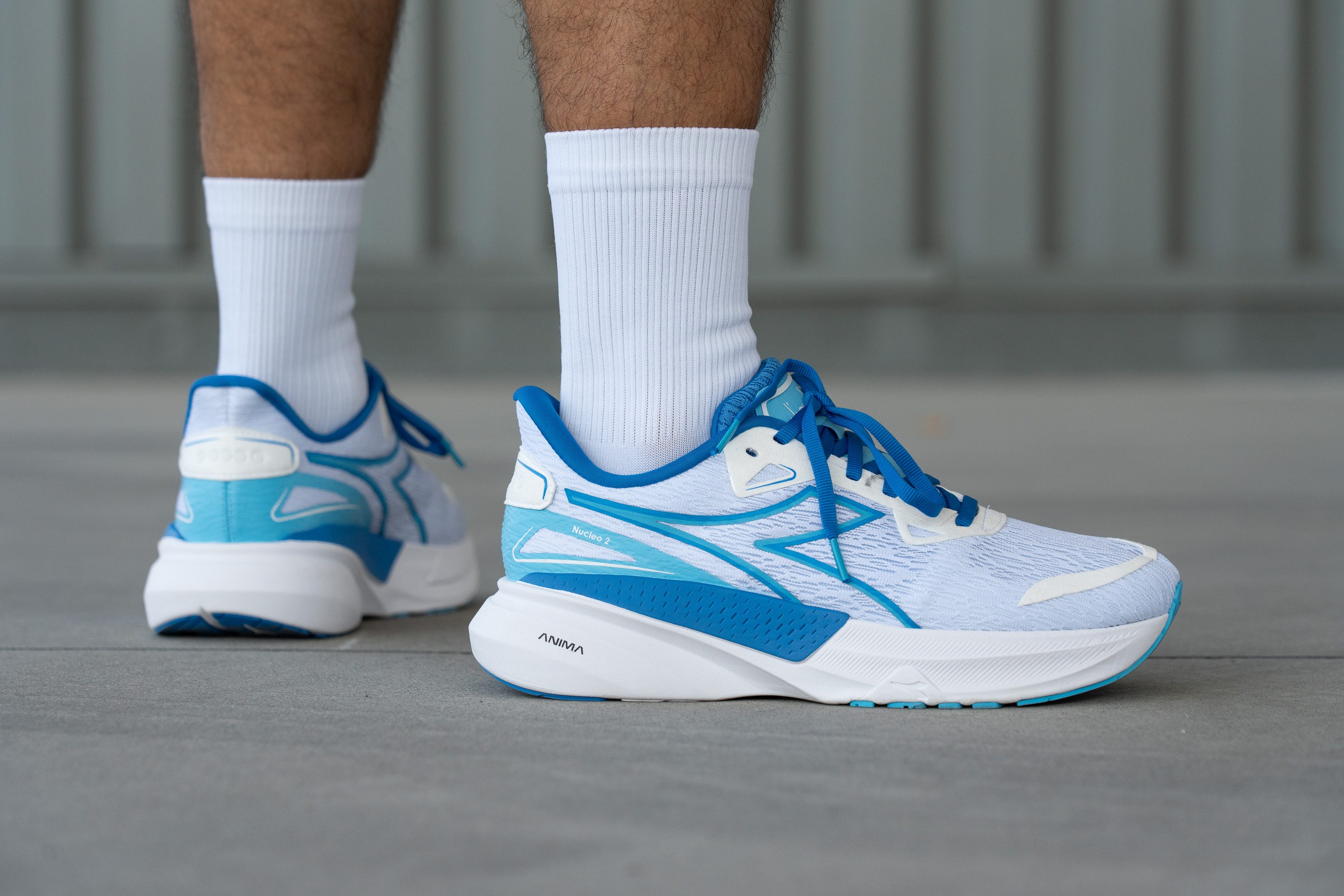
Who should NOT buy
We found in the lab that the Nucleo 2 feels lifeless underfoot, delivering one of the lowest energy return results when factoring in its higher price. Luckily for you, the market is currently packed with bouncy daily trainers like the Adidas Supernova Rise 2 or the ASICS Novablast 5, both of which bring a much higher energy return.
We also think that the Nucleo 2’s price tag may push some runners away, as it doesn’t match the performance offered. From our perspective, the New Balance FuelCell Rebel v5 is a good alternative—it feels more responsive, much more fun to run in, and offers better value overall.
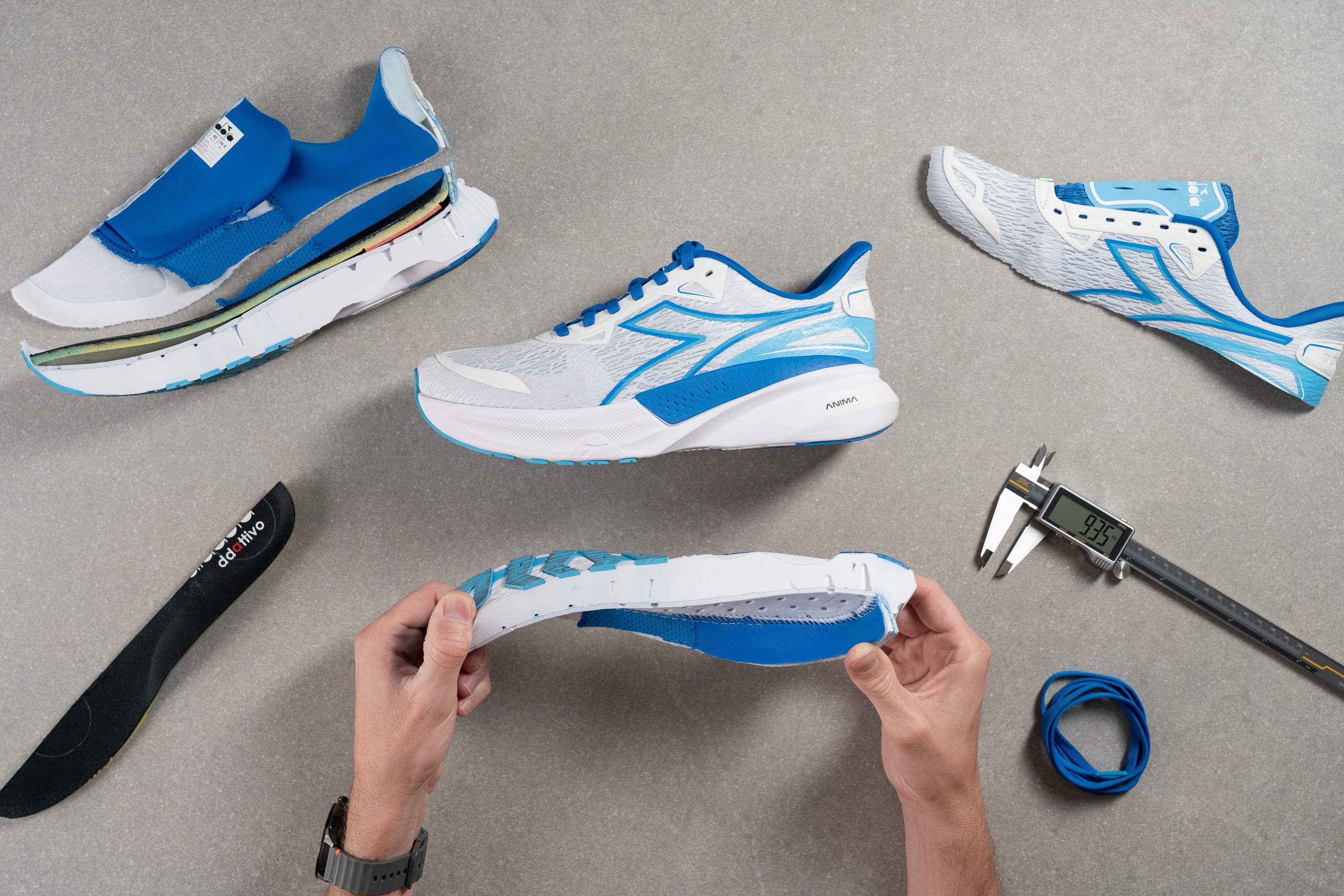
Cushioning
Shock absorption
The Nucleo 2 is a modern daily trainer with a supersized midsole that makes it a strong choice for long runs thanks to its extensive shock absorption. We measured 132 SA in the heel and an impressive 121 SA in the forefoot, and it’s especially in the front where the extra foam compared to average daily trainers becomes clearly noticeable.
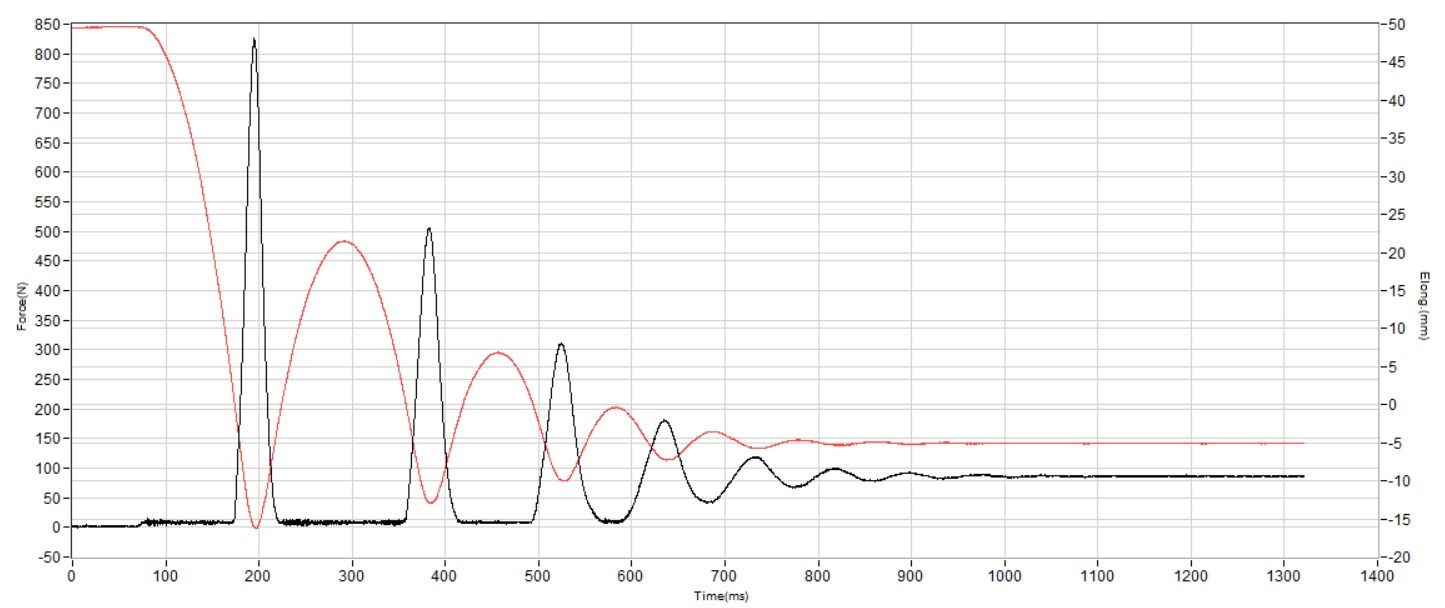
| Nucleo 2 | 132 SA |
| Average | 129 SA |
Energy return
The Nucleo 2 provides solid cushioning on landings, but the bounce fell short of expectations in our lab. With only 47.8% energy return in the heel and 52.2% in the forefoot, Diadora still has work to do.
In our view, this shoe should reach around 60% to compete more closely with its main rivals.
| Nucleo 2 | 47.8% |
| Average | 58.5% |
Heel stack
We mentioned earlier the high stack height of the Nucleo 2, but now it’s time for precise numbers from our calipers.
Our measurement showed 38.7 mm in the heel, just under the 40 mm mark often linked to the maximalist club, yet still far above the average shoe.
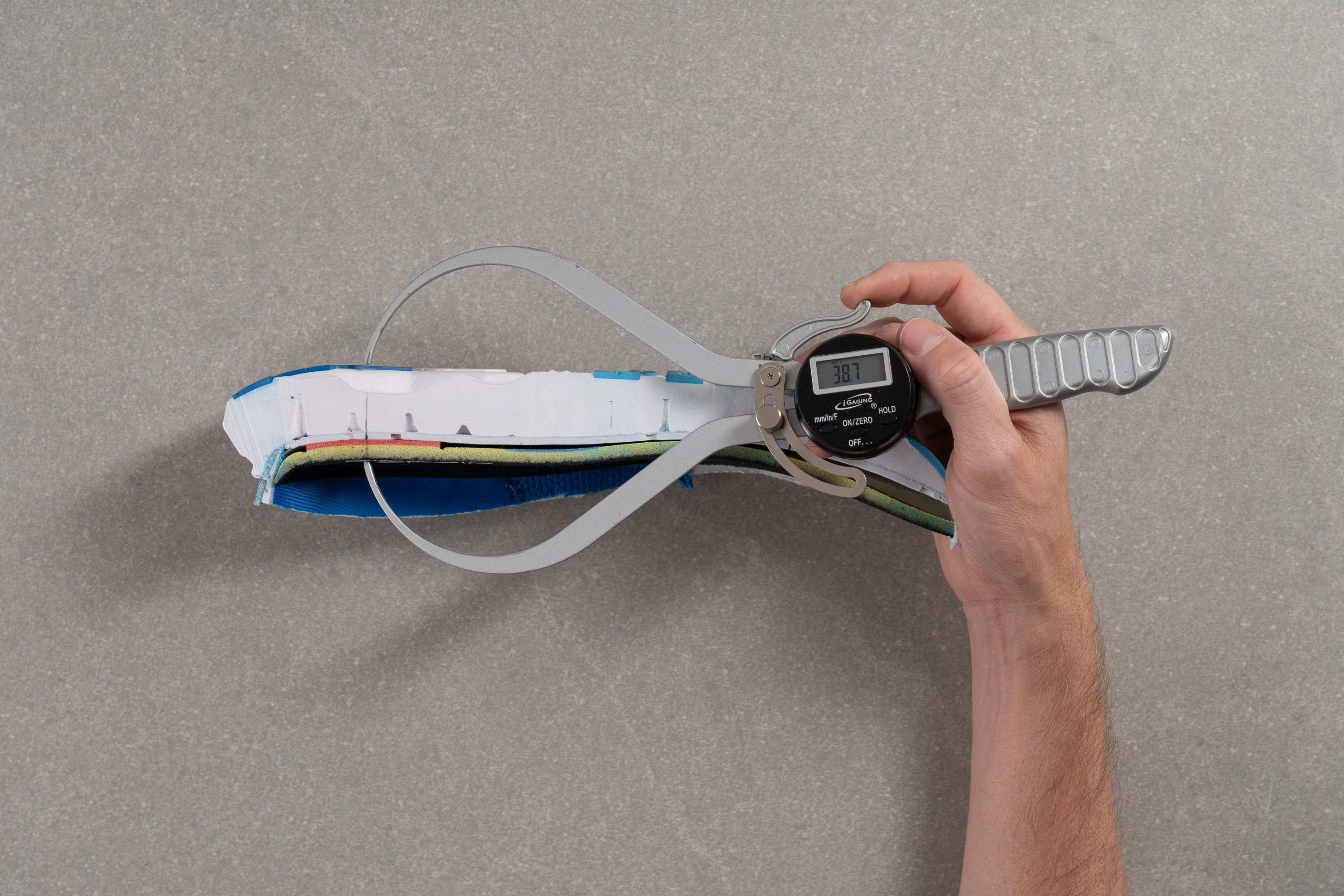
| Nucleo 2 | 38.7 mm |
| Average | 34.8 mm |
Forefoot stack
We tested the forefoot stack with our caliper and found it at 30.7 mm, slightly under the spec of 33 mm. Even so, this thick-and-protective layer of foam gives mid and forefoot strikers plenty underfoot for cushioned landings.
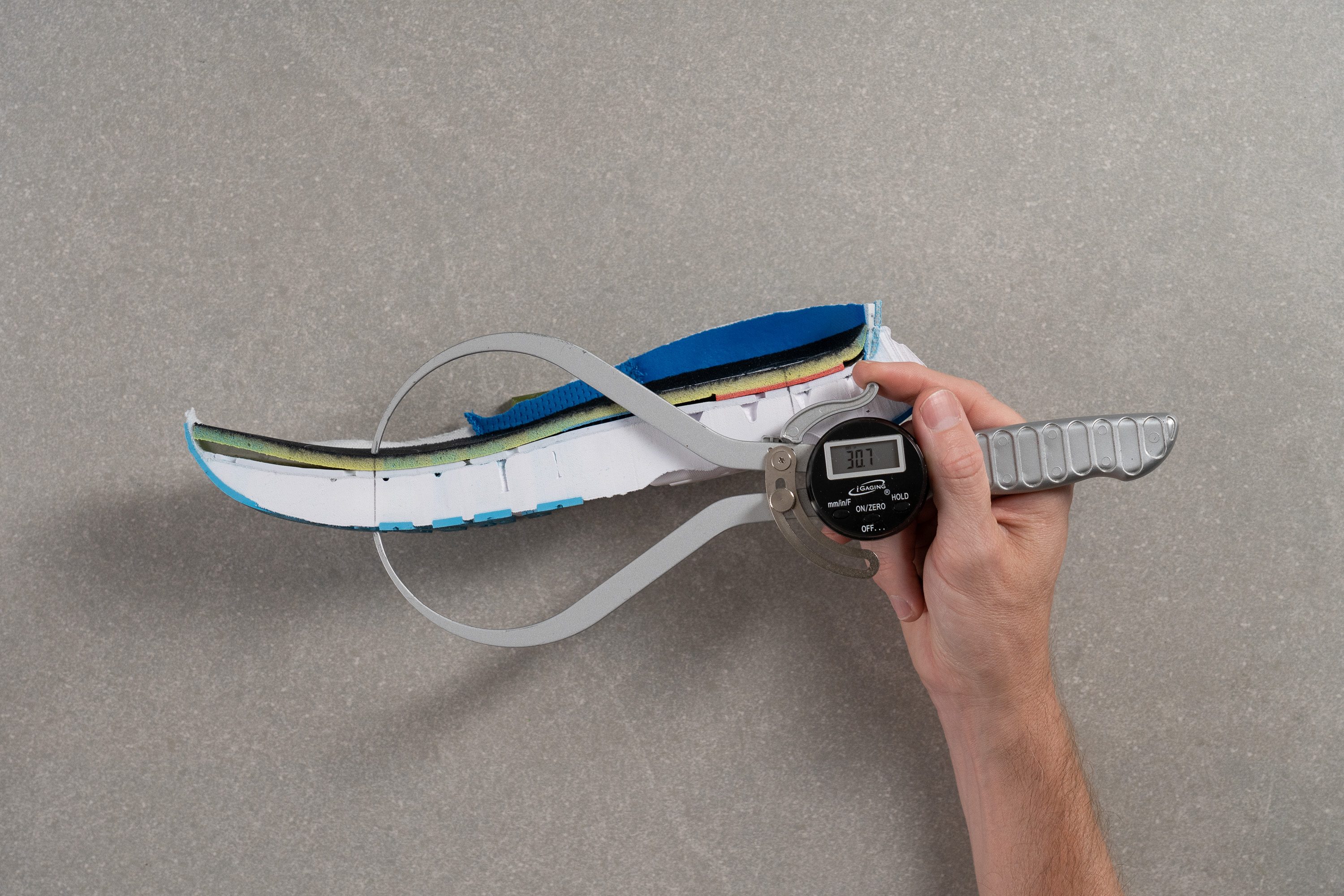
| Nucleo 2 | 30.7 mm |
| Average | 26.2 mm |
Drop
Our measurements revealed a heel-to-toe drop of 8.0 mm, not the official 5.0 mm. This notable difference makes the Nucleo 2 feel more like a regular trainer than a low-drop shoe, which mainly favors heel strikers.
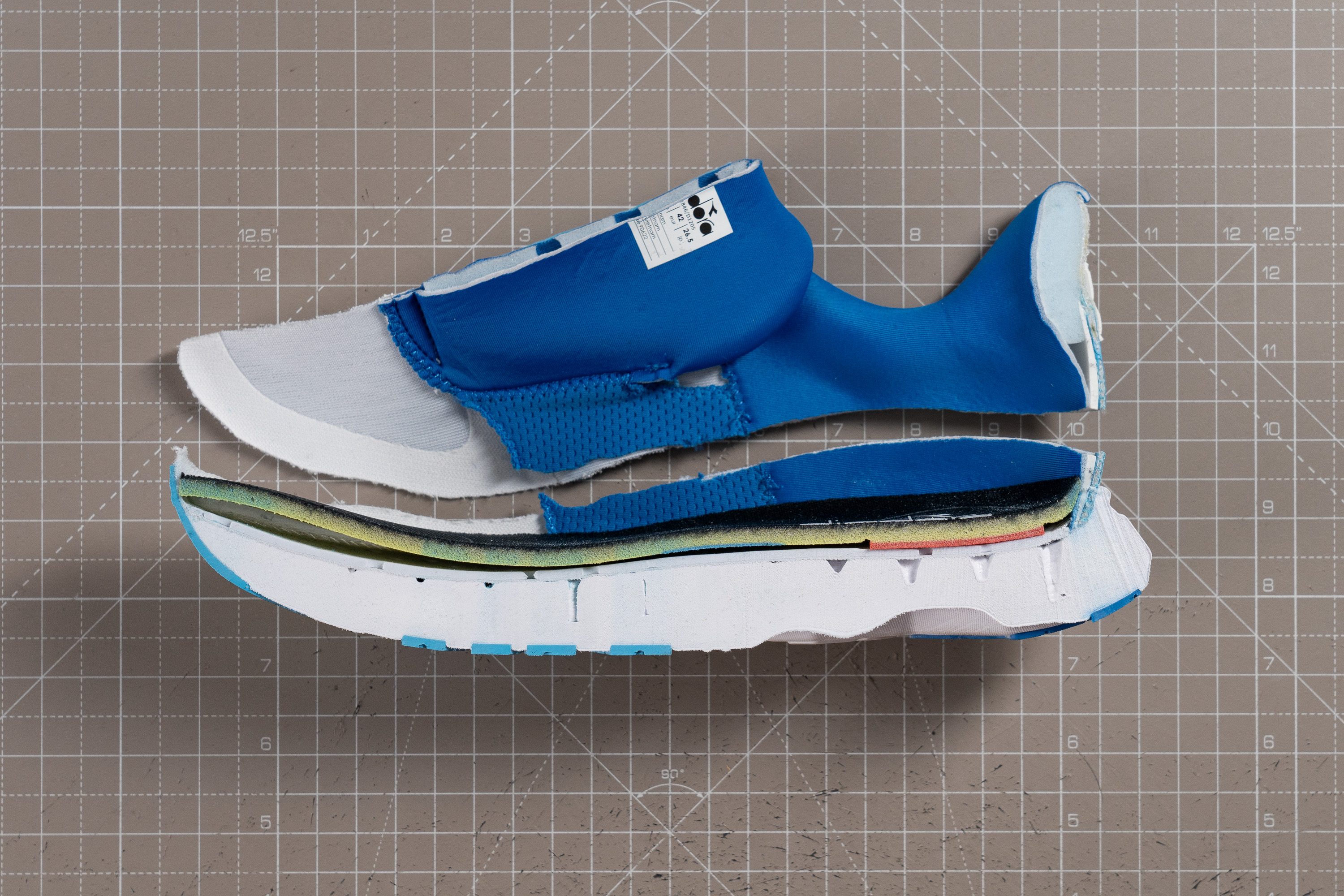
| Nucleo 2 | 8.0 mm |
| Average | 8.6 mm |
Midsole softness
The foam used here is the standard EVA-based ANIMA, not the supercritical ANIMA N2 found in the Atomo Star. As a result, energy return dropped below 50% in the heel, and we noticed the ride feels noticeably firmer compared to its more expensive sibling.
Our durometer measured 17.9 HA, which is still on the softer side, though it never reaches a plush sensation. The limited energy return also makes the shoe feel firmer and less lively than the numbers might suggest.
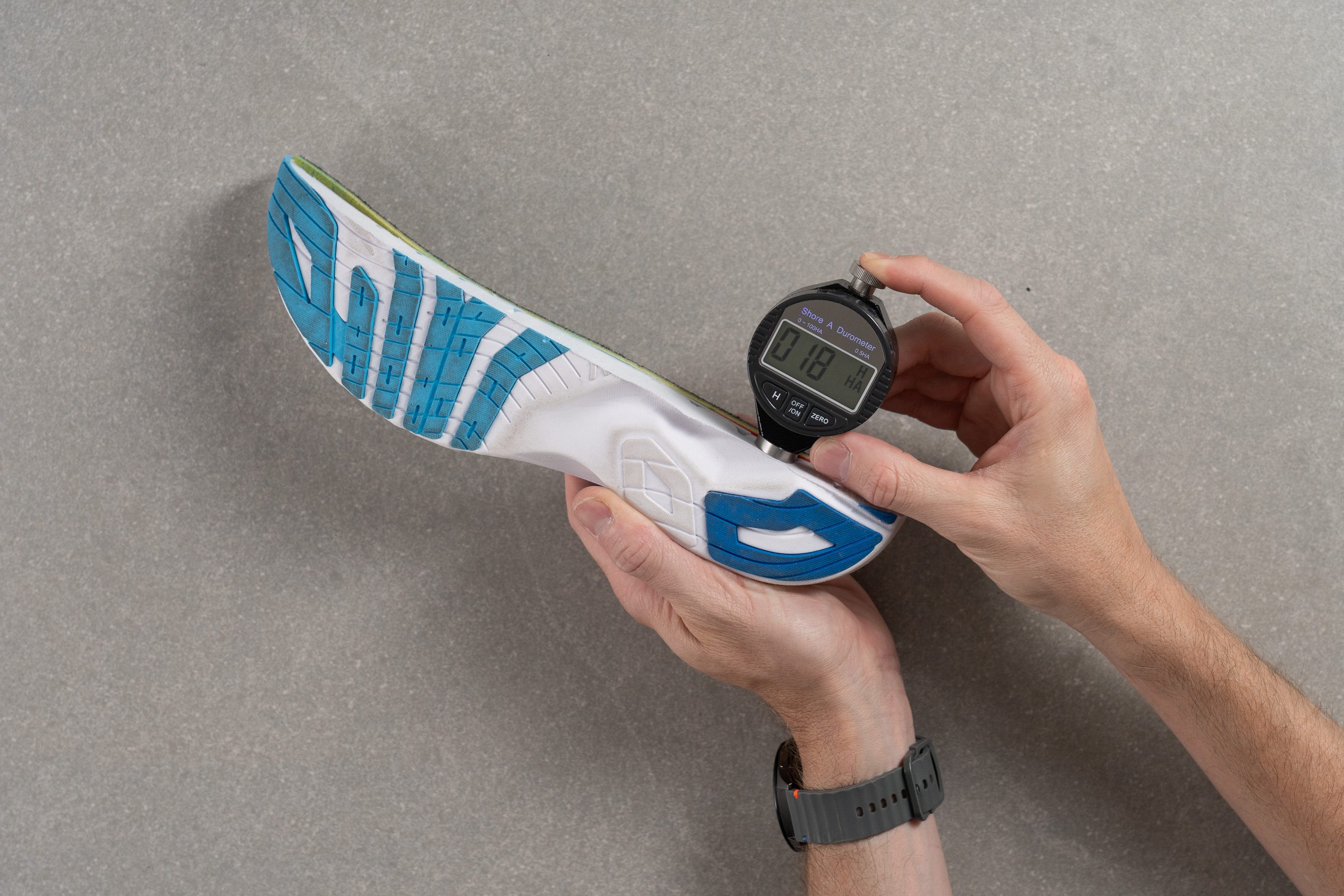
| Nucleo 2 | 17.9 HA |
| Average | 20.4 HA |
Rocker
Viewed against the rulers, the forefoot curvature starts quite late, creating only a modest rocker. At the back, the heel also rises off the ground rather late, far less pronounced than the more aggressive designs seen in recent models from other brands.
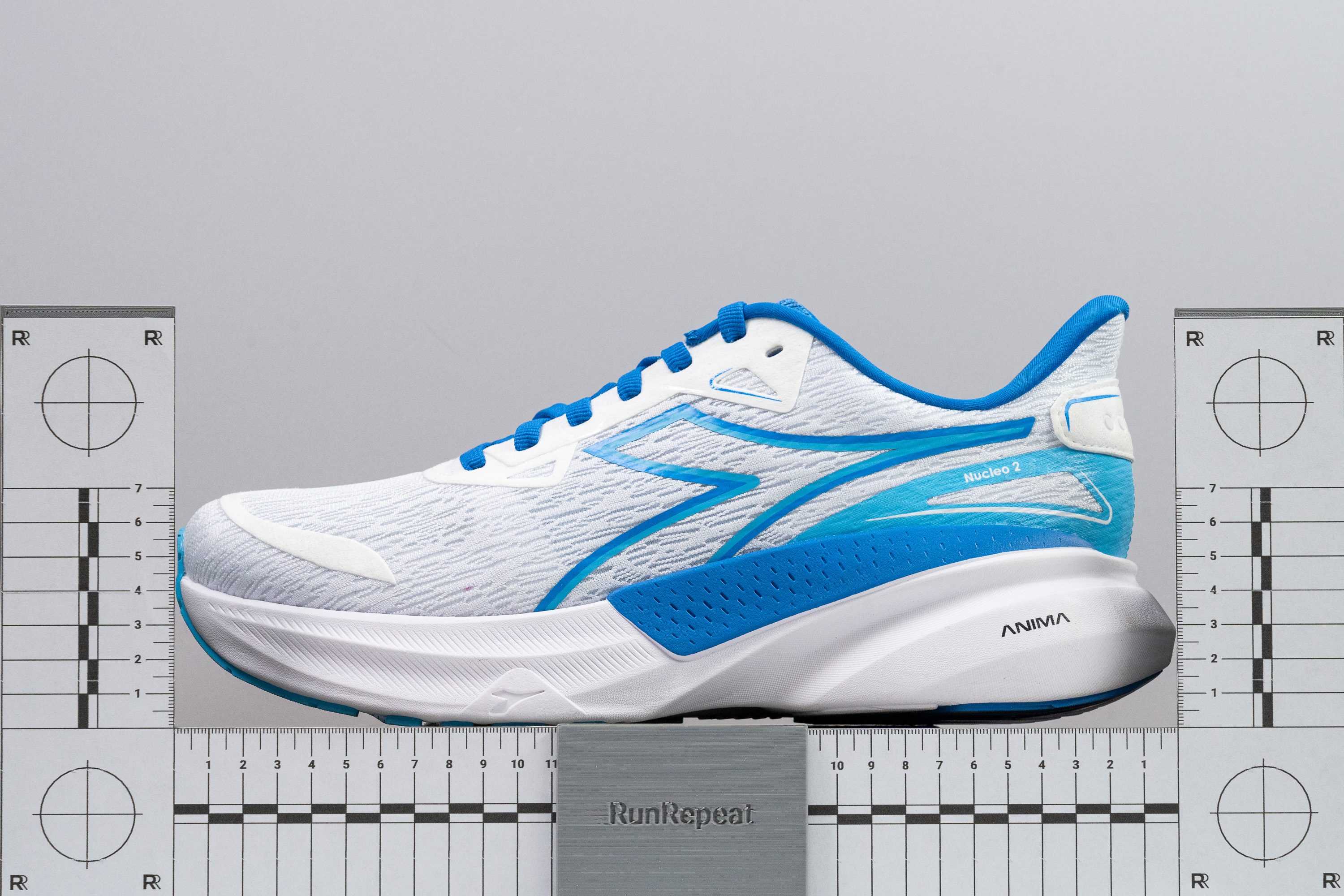
Size and fit
Size
Diadora Nucleo 2 fits true to size (11 votes).
Width / Fit
In our lab tests, we’ve seen Diadora often favor narrow builds. This time, though, the Nucleo 2 gave us a pleasant surprise with noticeably more room in the toebox, at least based on first impressions. To confirm, we created a replica of the shoe using our custom gel solution.
Our measurement came out at 97.5 mm, validating the extra space we sensed compared to other Diadora models.
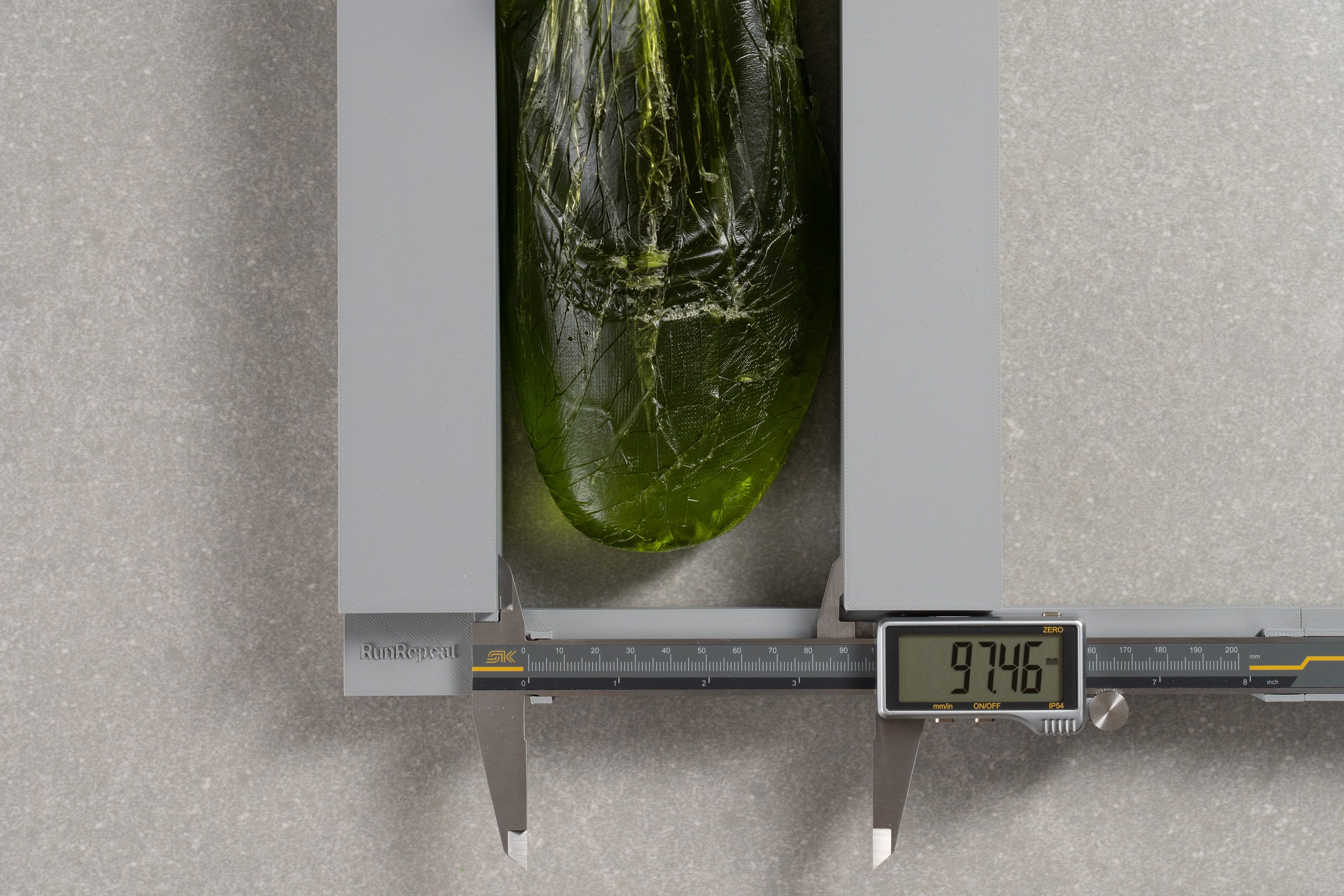
| Nucleo 2 | 97.5 mm |
| Average | 95.1 mm |
Toebox width
The toebox maintains its classic European tapered shape, which we quantified with our calipers at 72.0 mm.
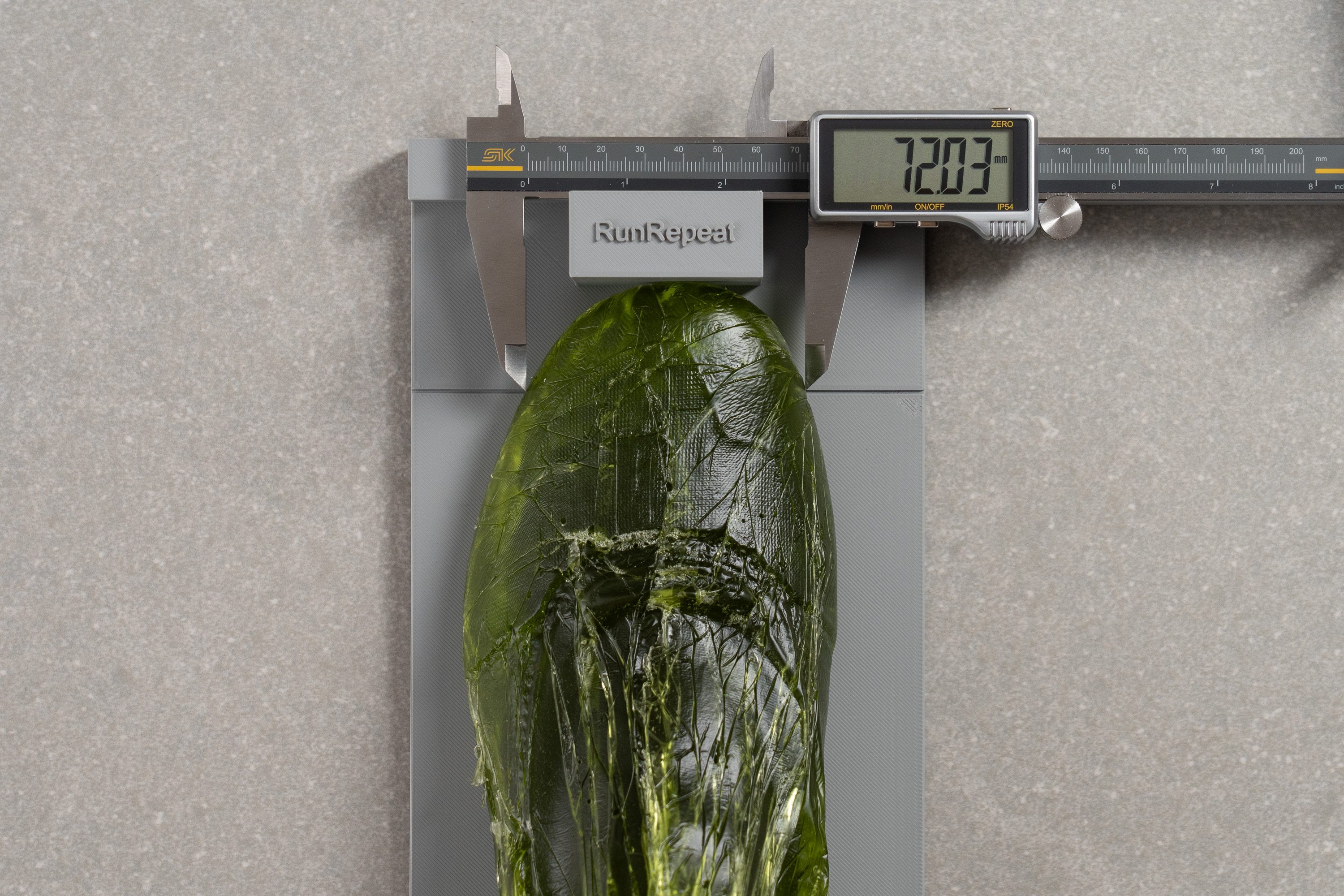
| Nucleo 2 | 72.0 mm |
| Average | 73.2 mm |
Toebox height
We tested the toebox height and found it not very generous, though it should rarely cause pressure problems.
Still, runners who enjoy an extra-roomy vertical space may find the 25.6 mm measurement a little tighter than desired.
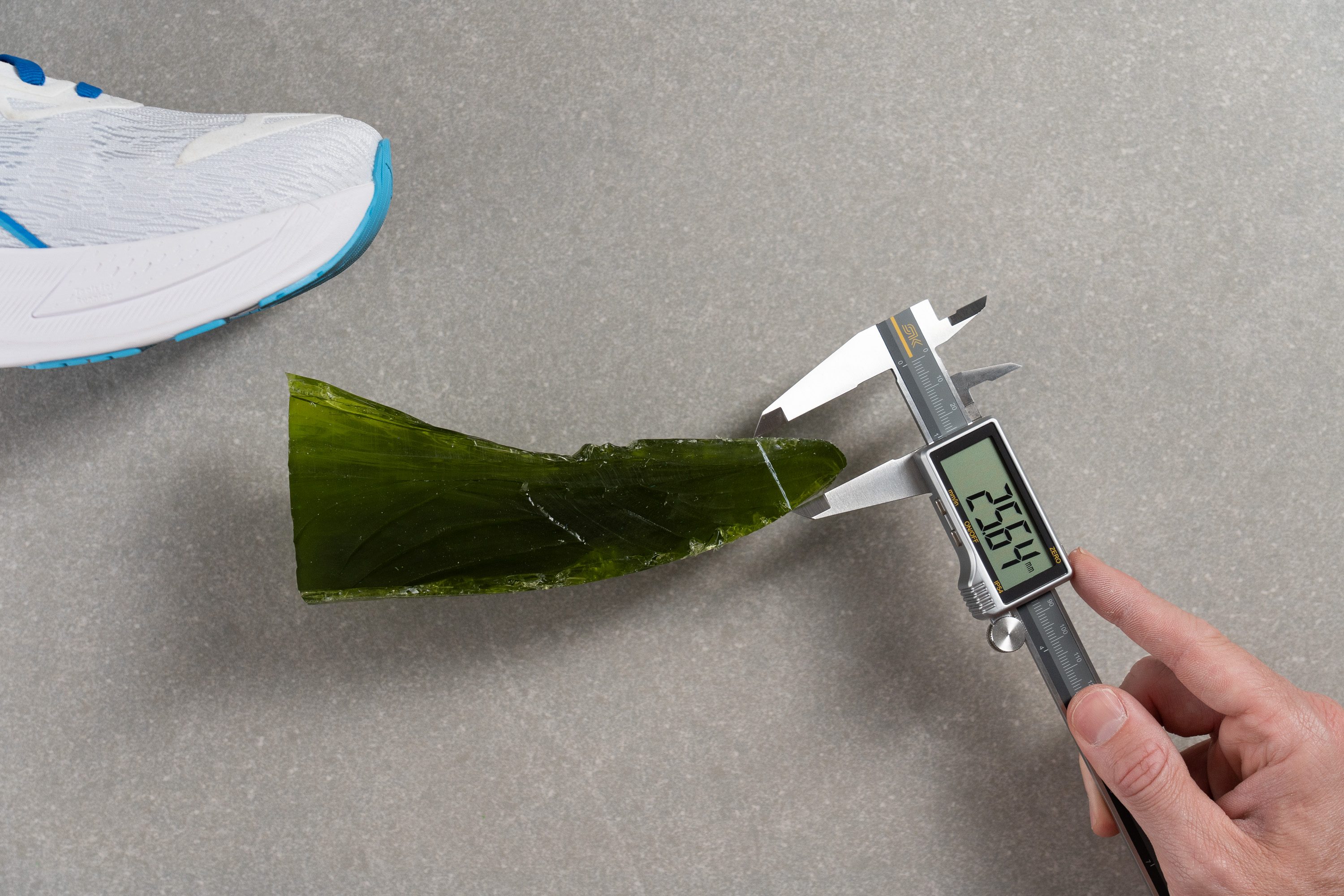
| Nucleo 2 | 25.6 mm |
| Average | 27.1 mm |
Traction / Grip
Traction test
In our lab test, the Duratech 5000 rubber delivered solid traction. With a 0.47 score, it provides reliable grip for both dry and wet conditions, making the Nucleo 2 an easy choice for runners seeking just one dependable shoe.
| Nucleo 2 | 0.47 |
| Average | 0.48 |
Outsole design
The outsole of the Nucleo 2 uses two-tone blue Duratech 5000 rubber alongside large sections of exposed white ANIMA foam. Rubber coverage is arranged in segmented pods across the forefoot, lateral edge, and heel, while the central areas remain open to reduce weight.
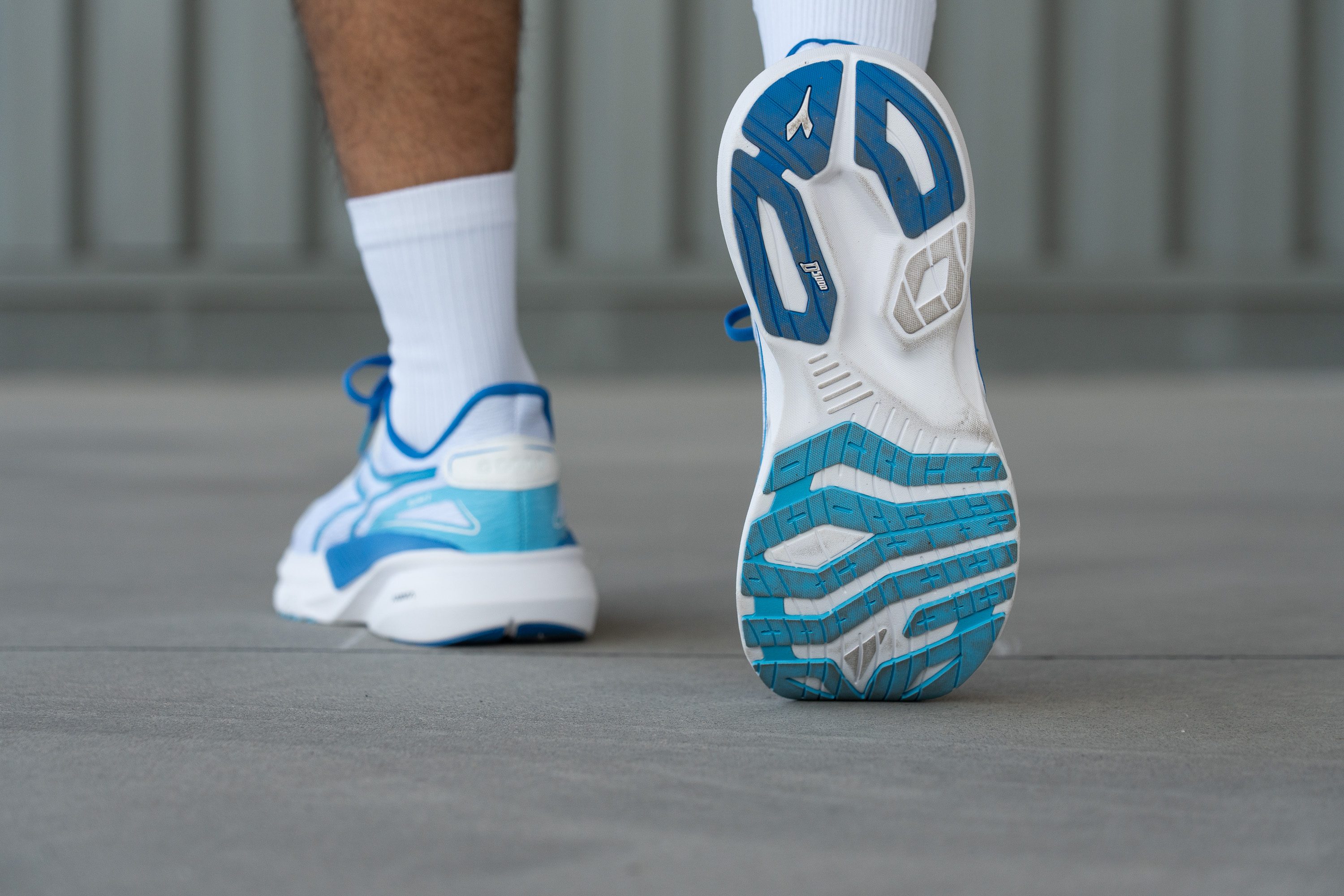
Flexibility / Stiffness
Because of the Nucleo 2’s tall stack height, flexibility is clearly limited. When we tested it in the lab with a 30-degree bend, the shoe required 15.0N of force, which places it on the rigid side and confirms its firm structure.
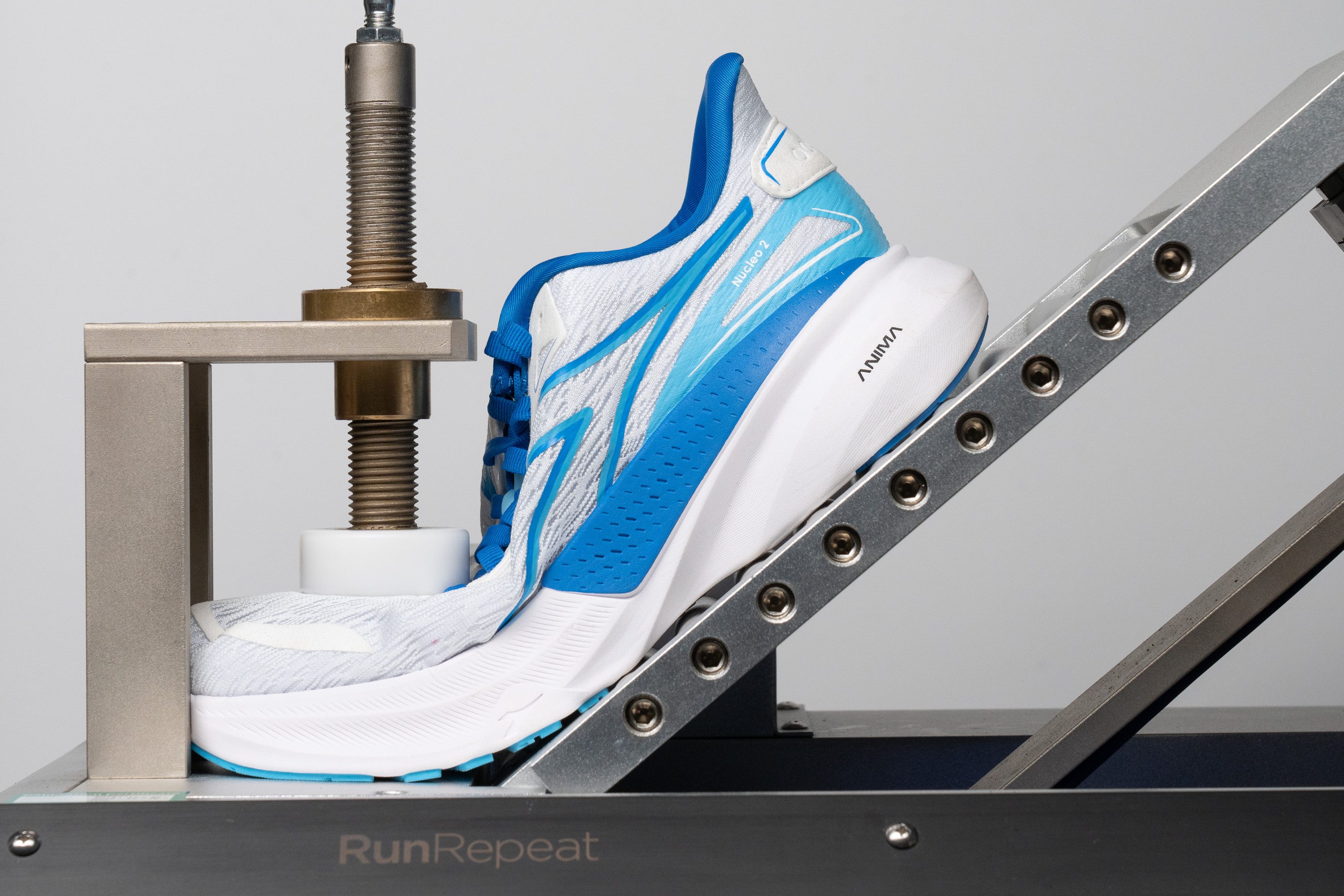
| Nucleo 2 | 15.0N |
| Average | 15.3N |
Weight
One clear benefit of the outsole’s limited rubber coverage is weight reduction, with the shoe coming in at 9.75 oz or 276g. While not a lightweight model, non-supercritical EVA foam is usually heavier, which makes this result a positive outcome.

| Nucleo 2 | 9.7 oz (276g) |
| Average | 9.3 oz (264g) |
Breathability
The engineered mesh upper of the Nucleo 2 is clearly designed with comfort in mind, and it delivers a soft, pleasant feel on foot. It’s not an ordinary shoe, and its premium touch is noticeable right away.
That said, the absence of ventilation holes raised our doubts about airflow from the beginning. Without clear openings for air circulation, we suspected that breathability might not be its strongest area.
After performing our standard smoke test, those doubts were confirmed. The shoe scored 3/5, which is serviceable but falls short of the level we hoped for in a daily trainer.
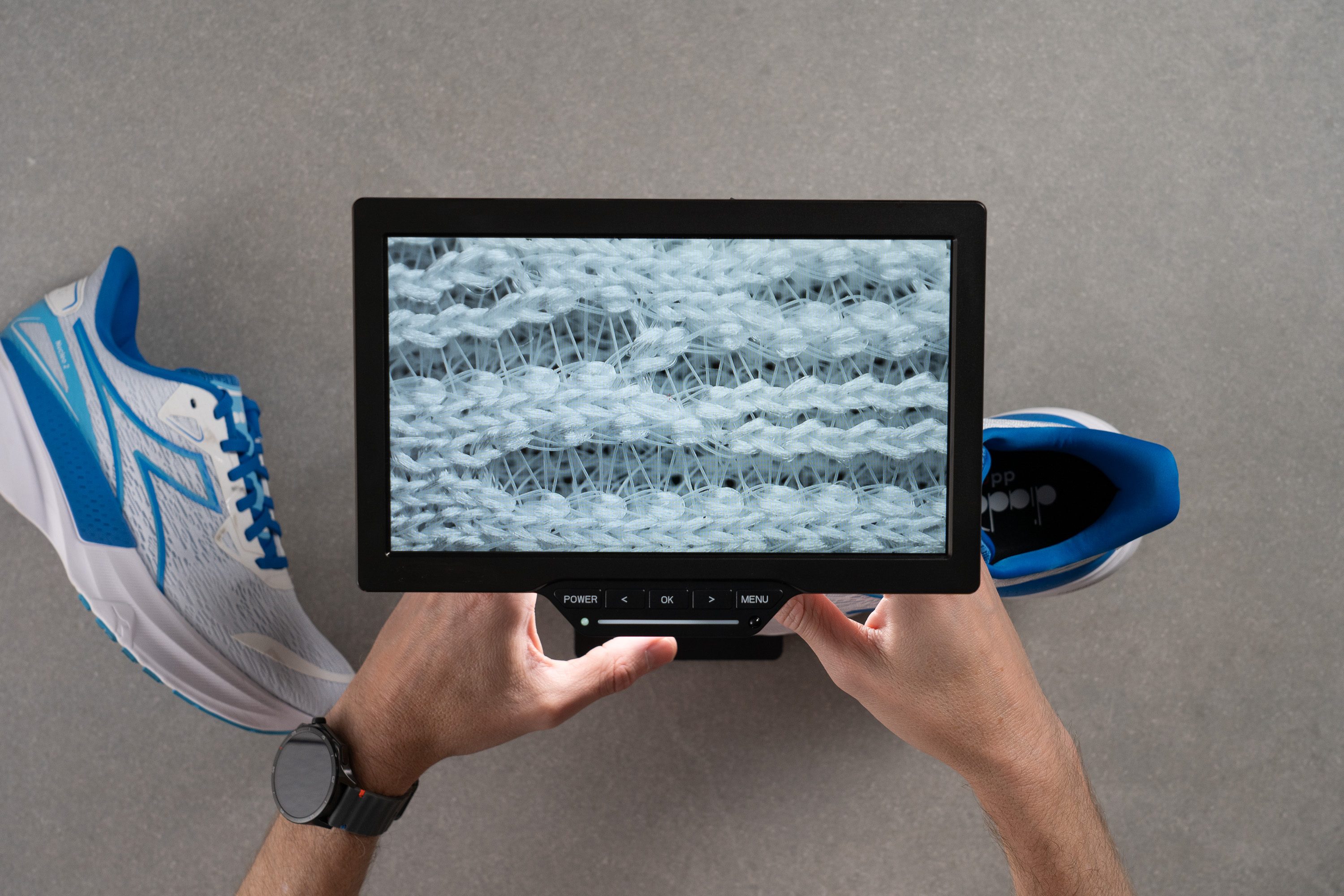
The mesh itself is built with two layers of variable density, a detail visible to the eye but even more apparent under our digital microscope.
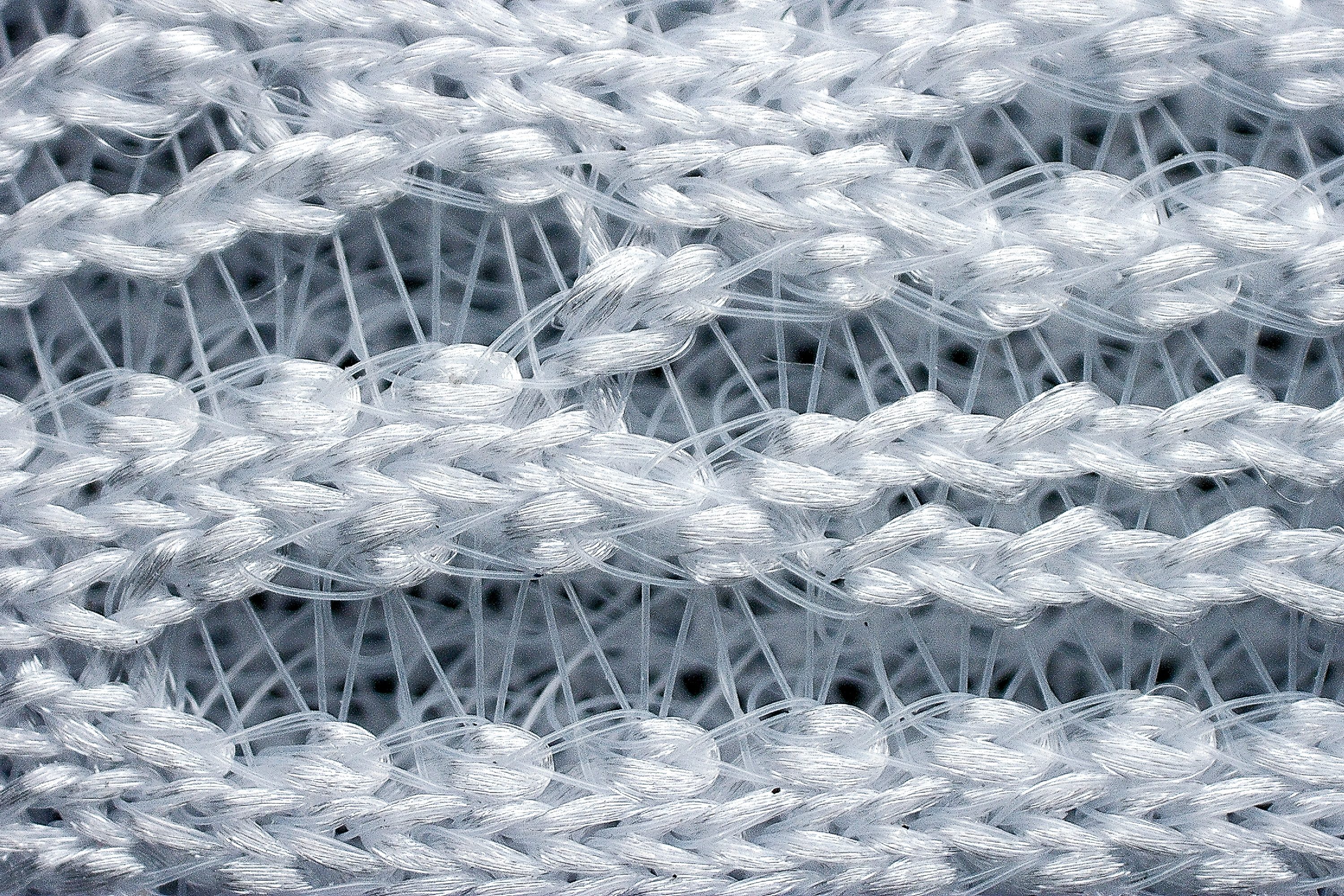
This layering provides structure and comfort, though it inevitably limits ventilation.
Breathability leaves space for refinement in a future update, but in our view, given the shoe’s focus on plush comfort, the result is understandable.
| Nucleo 2 | 3 |
| Average | 3.7 |
Stability
Lateral stability test
Although Diadora markets the Nucleo 2 as a neutral shoe, it could easily pass as a moderate stability model. With its large midsole sidewalls, wide landing platform, and high stiffness, it suits neutral runners who enjoy a touch of added support for daily training.
Torsional rigidity
The torsional rigidity is higher than average, which makes sense given the Nucleo 2’s tall stack height. Instead of bending easily through the midfoot, the shoe maintains a firm structure that keeps the platform stable and resists excessive twisting.
| Nucleo 2 | 4 |
| Average | 3.5 |
Heel counter stiffness
The heel counter scored only 3/5, which came as a real surprise. It’s the one element that doesn't go all-in giving support, likely because Diadora already provided plenty of stability through the other structural features.
| Nucleo 2 | 3 |
| Average | 2.9 |
Midsole width - forefoot
The midsole width clearly falls into oversized territory, measuring 118.8 mm in the forefoot, while the midfoot also sits on the wider end of the spectrum.
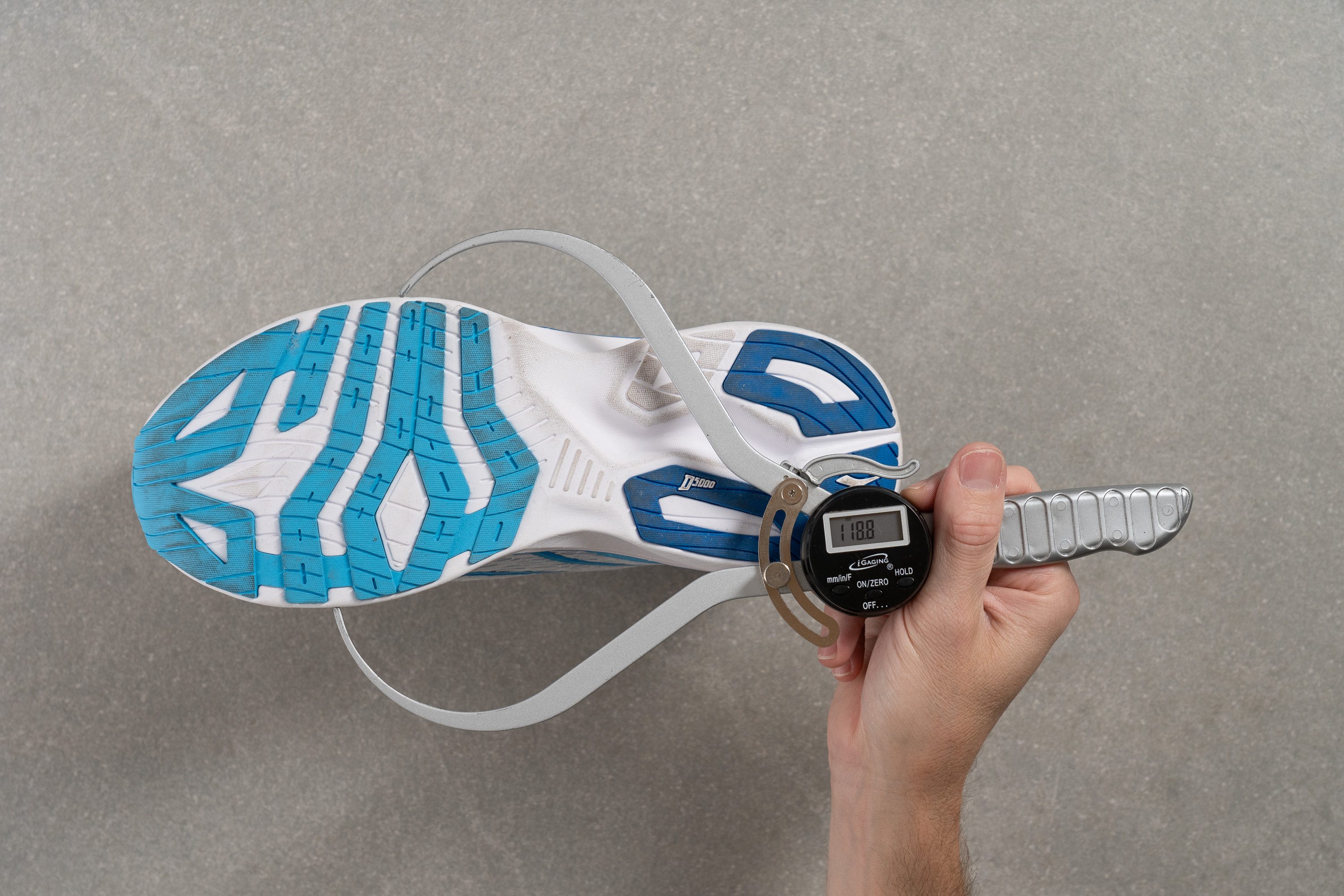
| Nucleo 2 | 118.8 mm |
| Average | 114.4 mm |
Midsole width - heel
The heel measures 94.7 mm, providing a wide platform that helps control lateral motion and gives heel strikers added stability on landings. While this reduces agility and playfulness, it places the Nucleo 2 in line with its main competitors’ midsole designs.
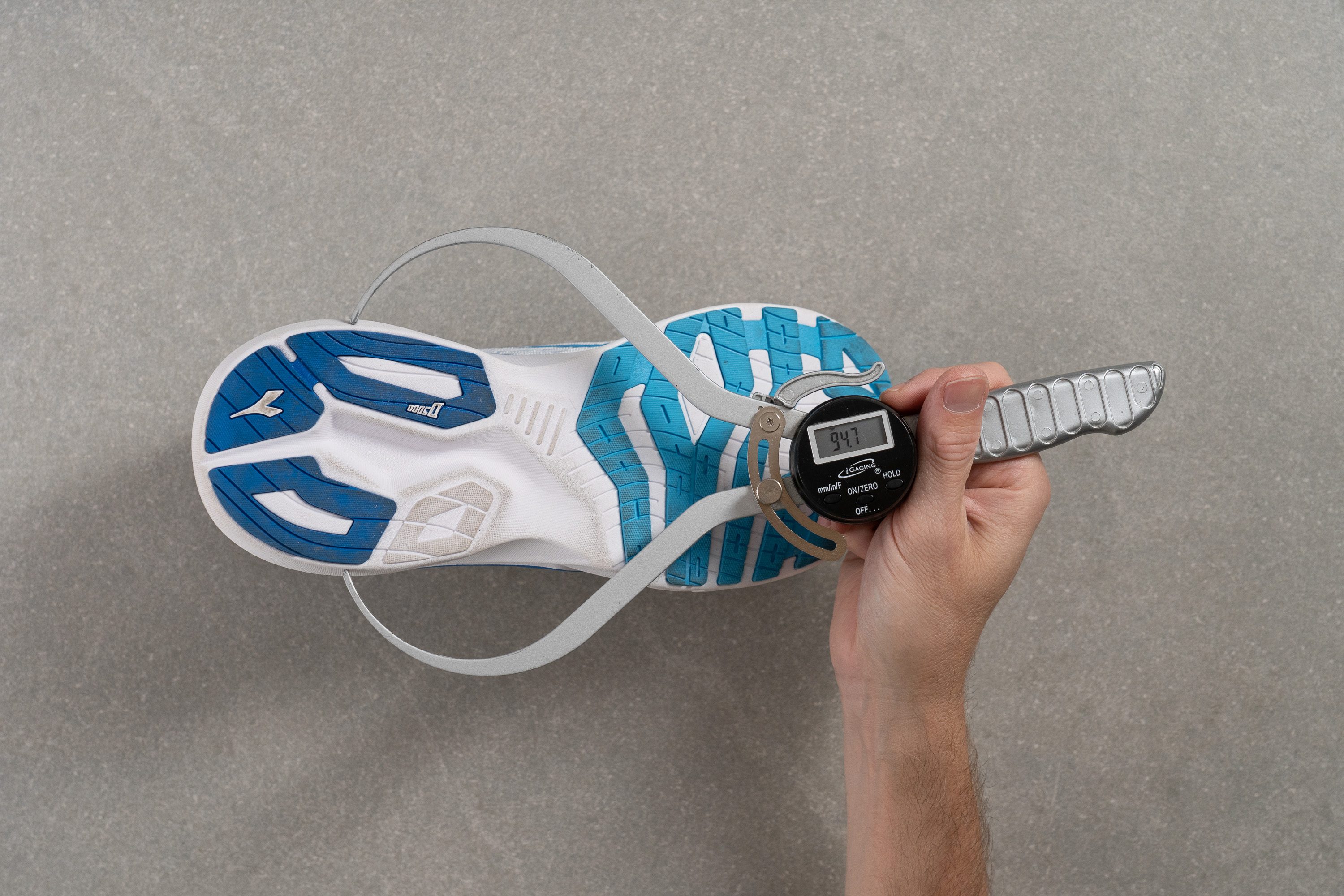
| Nucleo 2 | 94.7 mm |
| Average | 90.7 mm |
Durability
Toebox durability
The toebox material feels very comfortable, but that comfort comes at the cost of durability. In our test, the engineered mesh broke down instantly when the Dremel touched it, resulting in a clear 1 out of 5 rating.
| Nucleo 2 | 1 |
| Average | 2.6 |
Heel padding durability
In contrast, the heel lining proved impressively durable, earning a perfect 5/5. We’d gladly trade a bit of that toughness for more resilience in the toebox...
| Nucleo 2 | 5 |
| Average | 3.4 |
Outsole durability
Diadora’s Duratech 5000 rubber proved exceptionally tough in our test. After using the Dremel, we recorded only 0.7 mm of wear, showing that this outsole delivers an effective combination of strong durability and reliable grip.
| Nucleo 2 | 0.7 mm |
| Average | 1.1 mm |
Outsole thickness
The outsole is slightly thinner than what we usually measure in the lab at 2.5 mm, but this isn’t an issue for the Nucleo 2 since the Duratech 5000 rubber holds up strongly against abrasion.
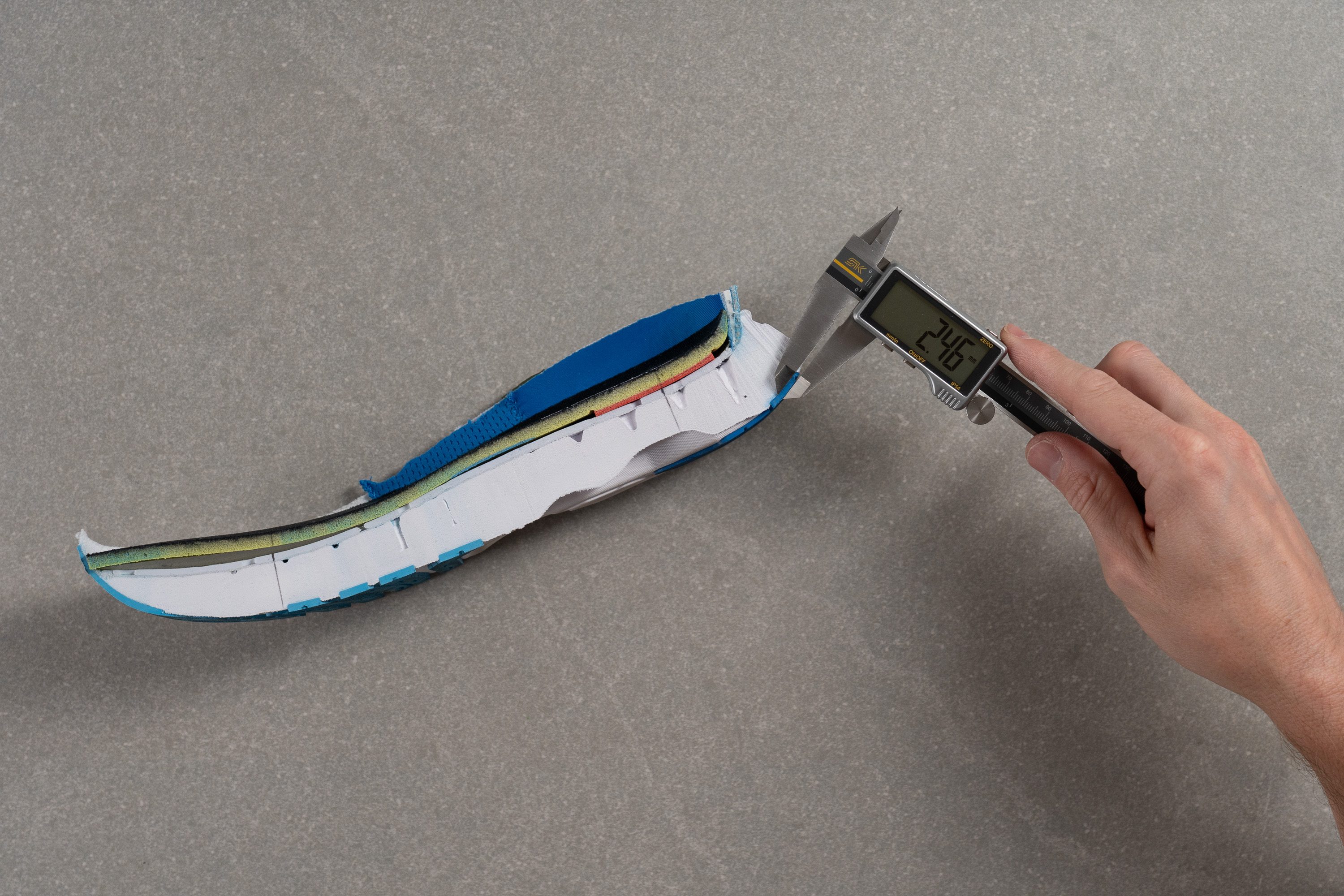
| Nucleo 2 | 2.5 mm |
| Average | 3.2 mm |
Misc
Insole thickness
One detail Diadora approached differently than most brands is the insole. We found it has varying thickness, reaching a maximum of 7.8 mm in our measurement in the heel.
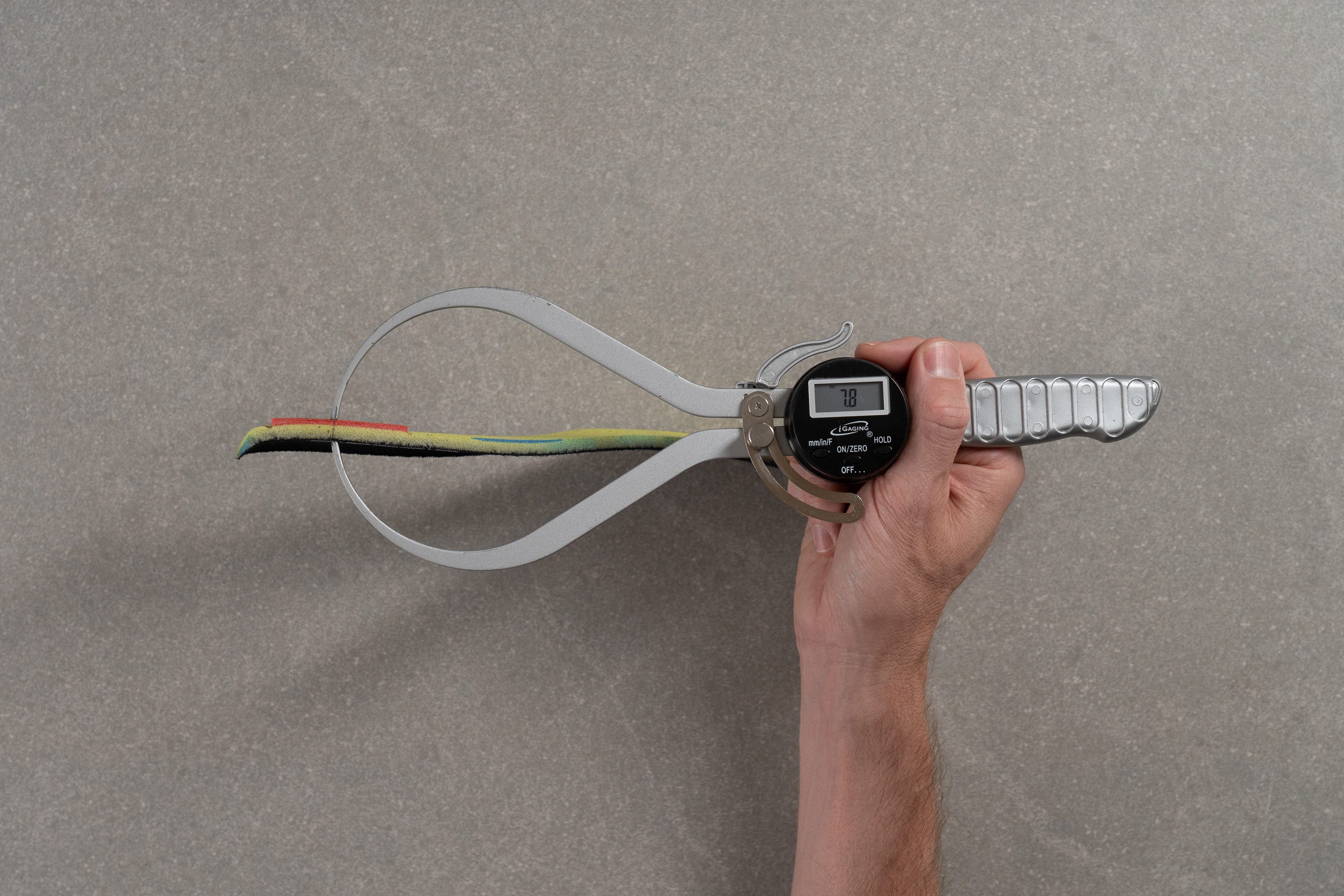
| Nucleo 2 | 7.8 mm |
| Average | 4.5 mm |
Removable insole
The insole is removable, allowing you to swap in a thinner option to create extra room in the toebox and a less steep heel to toe drop, because the stock insole has an elevated heel. While this does reduce cushioning, in this shoe the trade-off could be worthwhile for many runners.
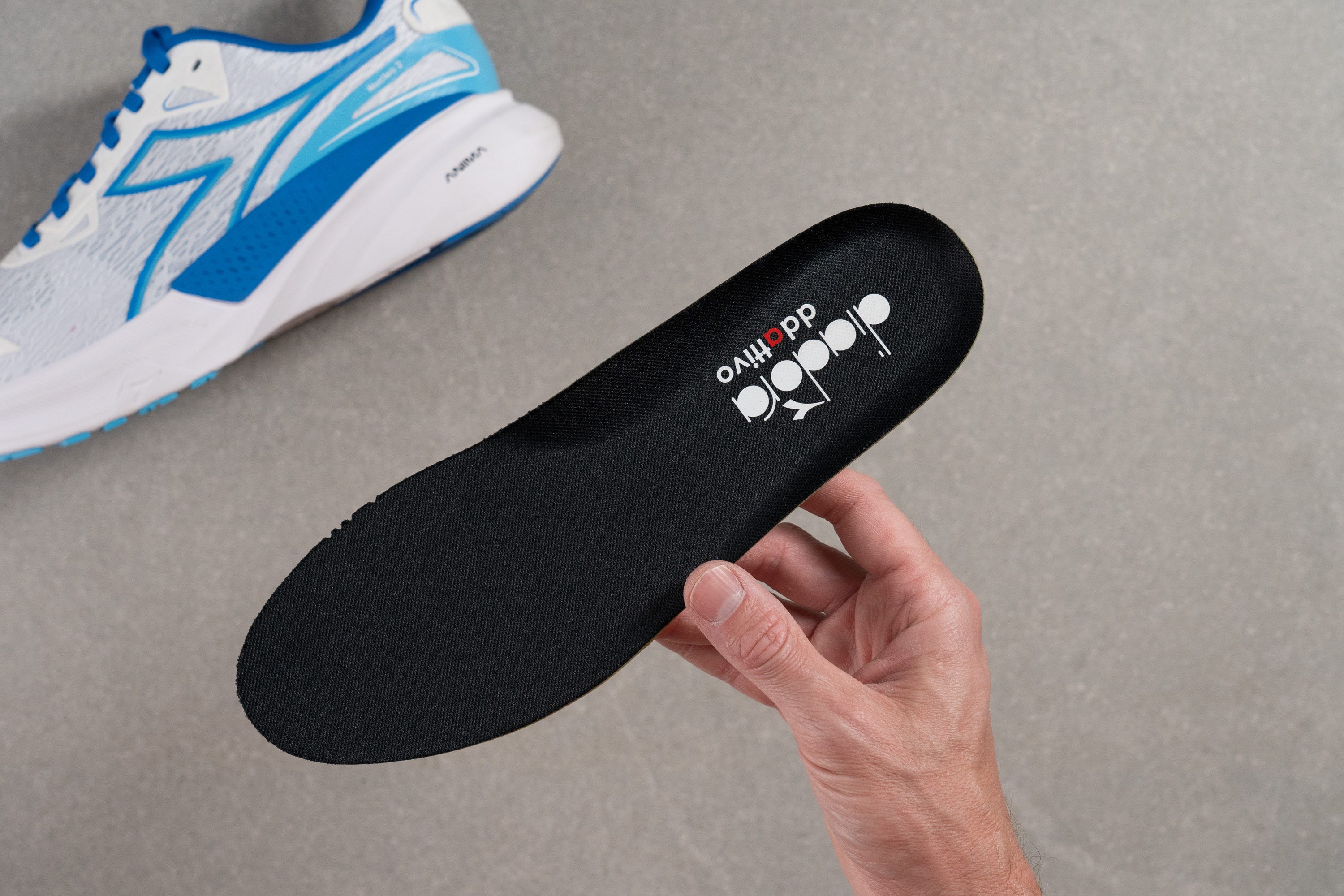
| Nucleo 2 | Yes |
Midsole softness in cold (%)
We measured a 27% change in softness after the Nucleo 2 spent 20 minutes in the freezer. That’s a decent result for EVA foam, though we still believe this shoe deserves a higher-quality material.
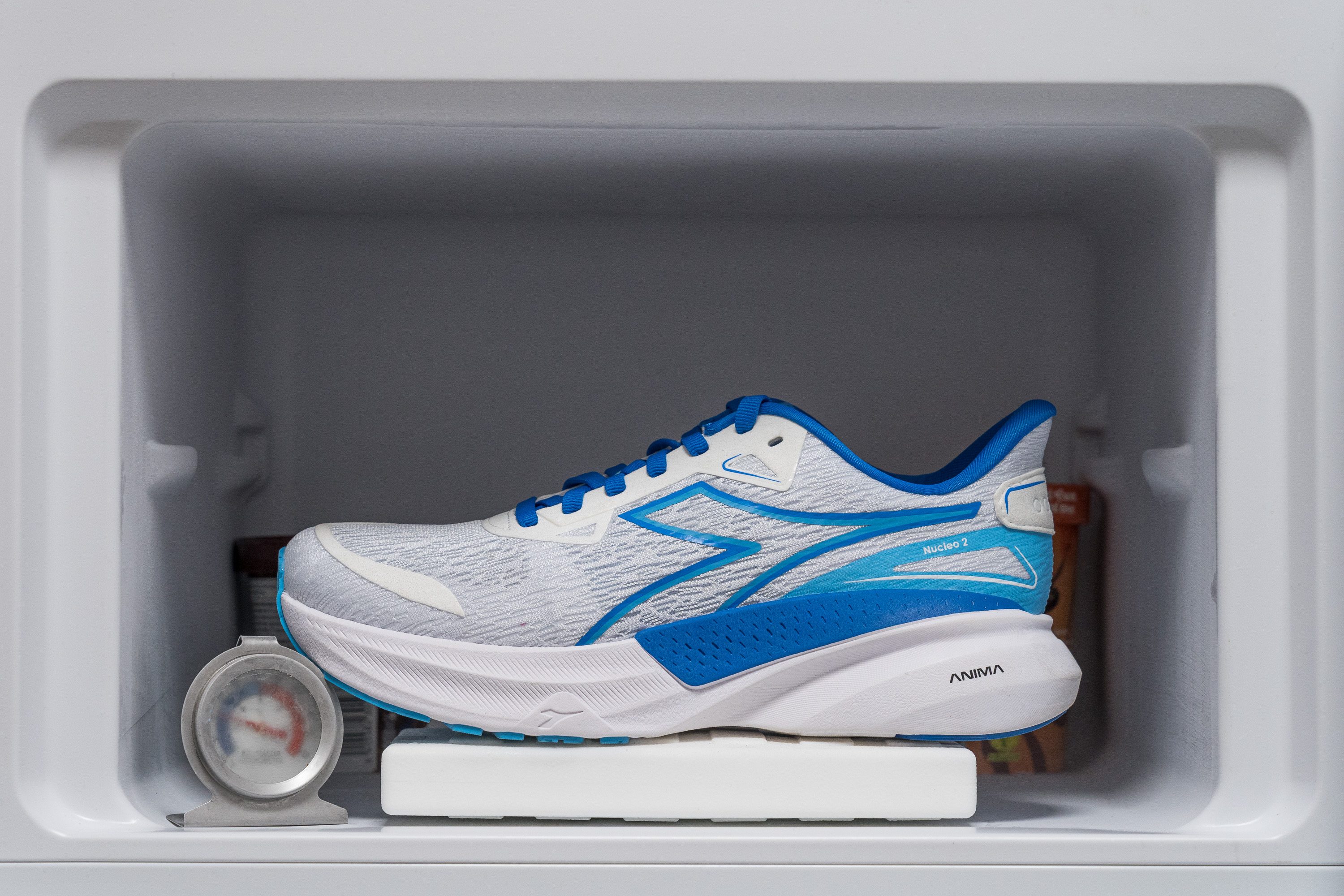
| Nucleo 2 | 27% |
| Average | 24% |
Reflective elements
Although the reflective details are not especially striking in terms of visibility, they are sufficient to confirm that the Nucleo 2 does include reflective elements.
| Nucleo 2 | Yes |
Tongue padding
Diadora aimed for a plush feel in the upper, and they delivered with 9.9 mm of tongue padding. Those who dislike bulky designs may not enjoy it, but runners seeking a comfortable daily trainer for everyday wear will appreciate the Nucleo 2.
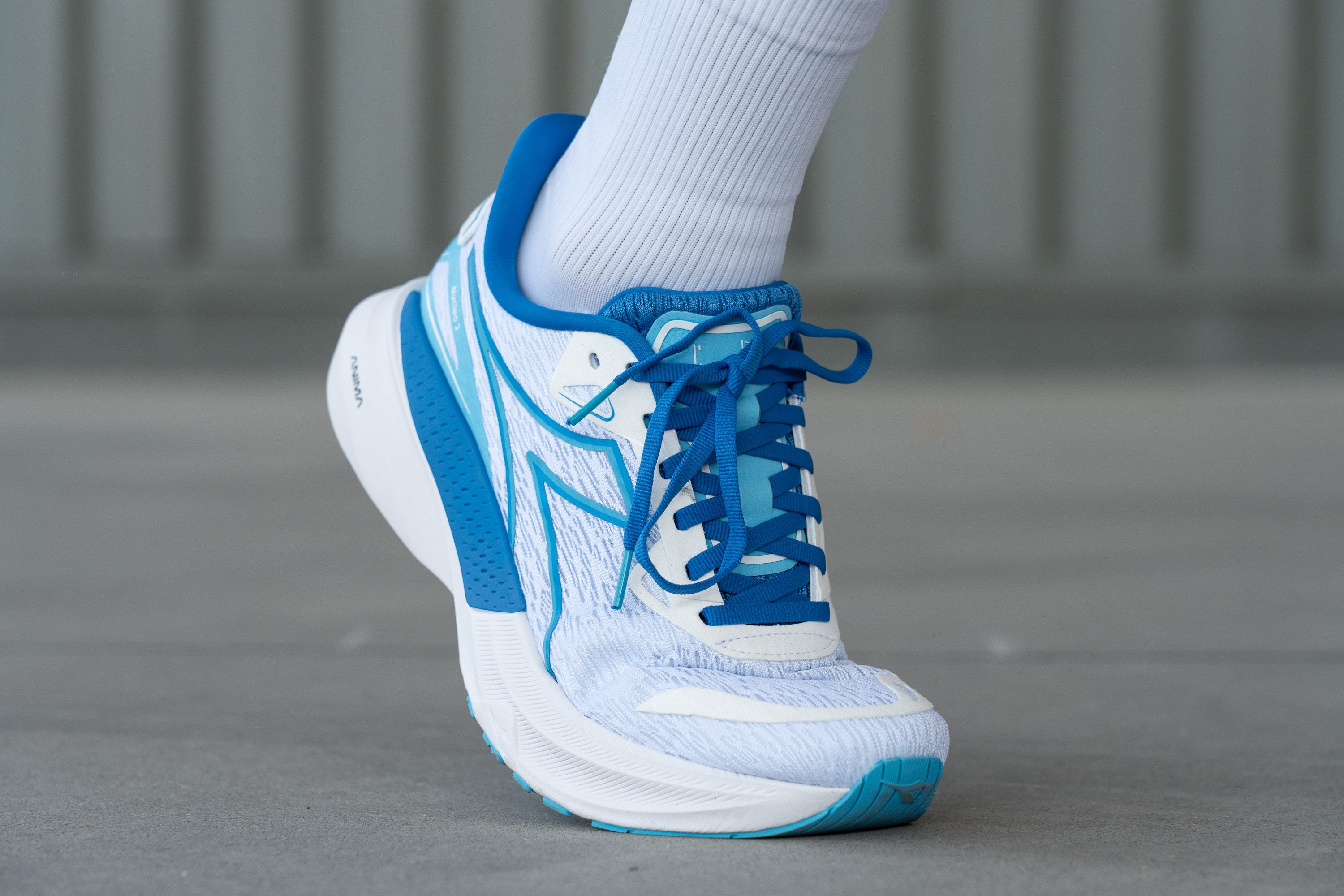
The lacing system features flat, sturdy laces running through reinforced eyelets within synthetic overlays for added structure. An extra top eyelet is included for those who prefer a heel-lock setup, offering better lockdown and reducing unnecessary foot movement.

| Nucleo 2 | 9.9 mm |
| Average | 5.8 mm |
Tongue: gusset type
The tongue is semi-gusseted, attached to the sides but not extending all the way to the top, which helps keep it secure while avoiding an overly tight or oppressive feel.

| Nucleo 2 | Both sides (semi) |
Price
As with many Diadora models, the price sits higher than most mainstream options, which feels harder to justify in a shoe built with low-energy EVA foam. Whether it’s worth it depends largely on how much you value bounce, though one clear advantage is the brand’s uniqueness—it’s really uncommon to spot another Diadora pair during your runs!
| Nucleo 2 | $160 |
| Average | $152 |
Heel tab
The heel collar features an extended upward flare that eases entry and reduces pressure on the Achilles.
The stitching is precise and uniform, running cleanly along the synthetic overlays and textile panels. This level of craftsmanship shows Diadora’s extra attention to detail, even with the shoe being produced in Vietnam rather than Italy like their top-tier models.
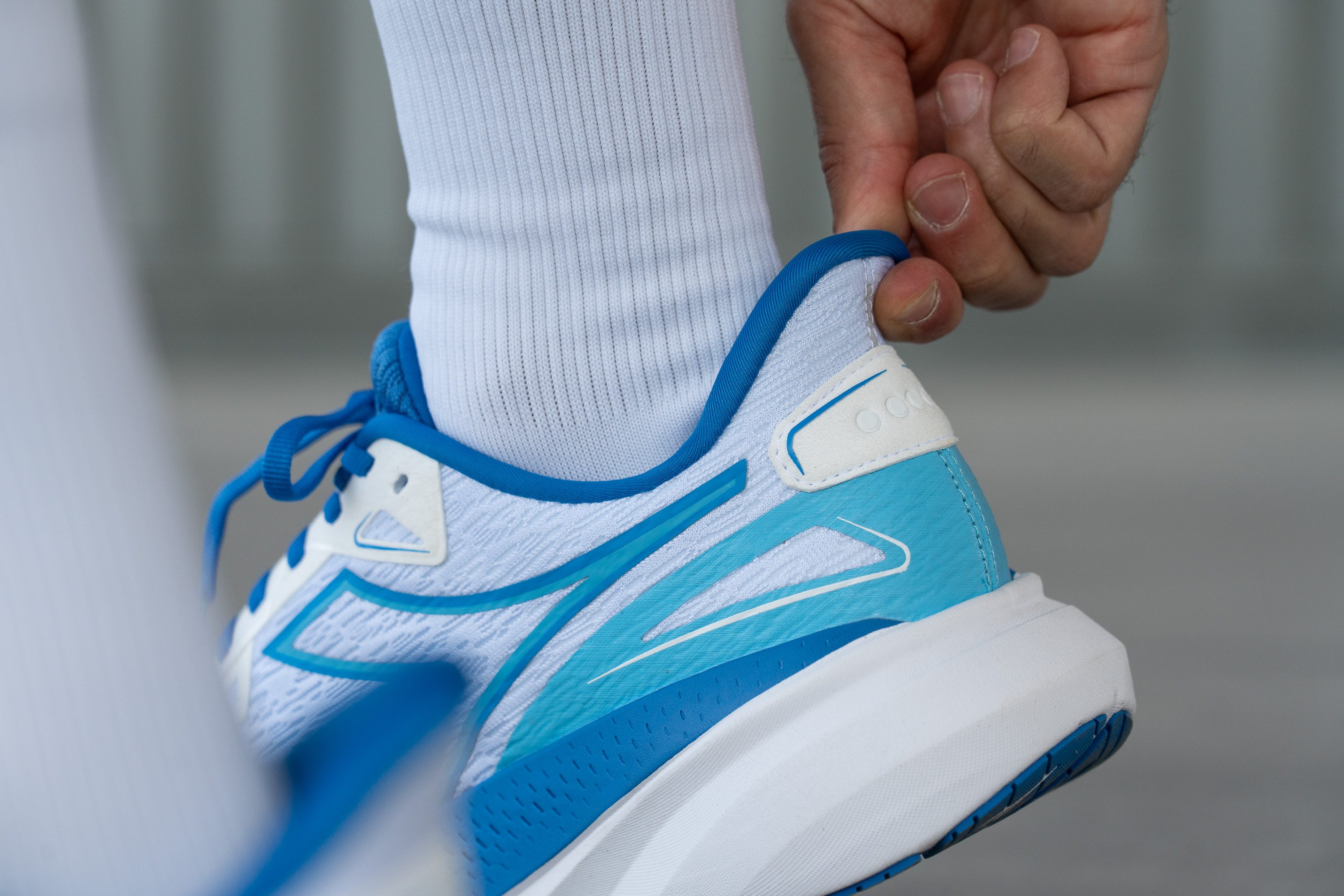
| Nucleo 2 | Extended heel collar |

















































